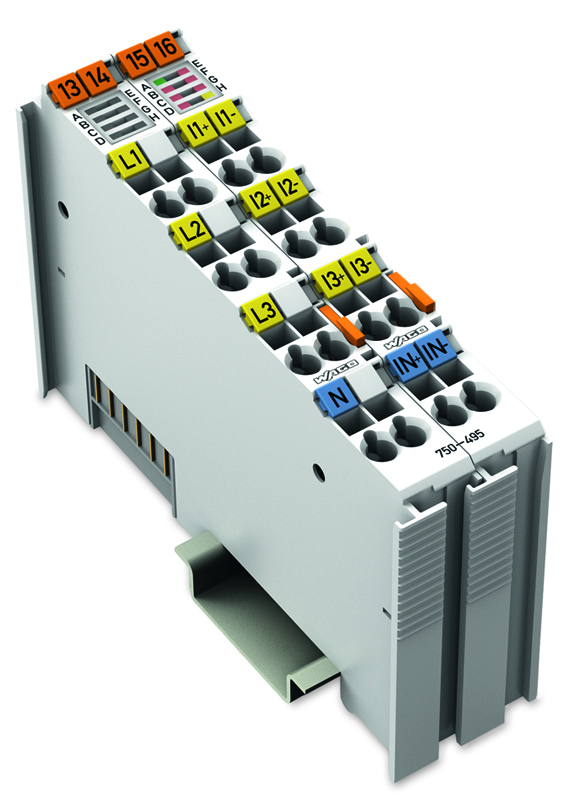 With the ever increasing focus on improving power efficiency, measuring the energy used is a fundamental requirement in helping reduce consumption. The default response is generally to use dedicated energy metering. However, the integration of digital control equipment with power monitoring capabilities provides a very cost effective solution as well as many other benefits to both users and installers. Andy Turtle, Automation Product Manager at WAGO, explains further.
With the ever increasing focus on improving power efficiency, measuring the energy used is a fundamental requirement in helping reduce consumption. The default response is generally to use dedicated energy metering. However, the integration of digital control equipment with power monitoring capabilities provides a very cost effective solution as well as many other benefits to both users and installers. Andy Turtle, Automation Product Manager at WAGO, explains further.
Within industries such as power generation, manufacturing, processing and building services, companies are taking the challenge of reducing energy consumption extremely seriously. The benefits are well known and can lead to substantial cost savings, whilst also helping to achieve CO2 reduction targets. Knowledge of power quality is equally important, for example to ensure costs of reactive power losses are minimised.
Many companies have taken up the challenge and achieved some quick wins by adopting simple measures such as switching off equipment that is not being used. However, to achieve further gains in reducing power consumption and costs, the role of automation becomes vital.
When considering this issue, first it is necessary to understand where power is being used and when. However the cost and complexity of installing dedicated power monitoring on all pieces of equipment or sections of a system can be prohibitive. The good news is that a solution to this dilemma exists already. Thanks to the increasing convergence of digital control equipment, it is possible to combine the installation’s programmable controller with the necessary power monitoring capabilities of a standalone power monitor. Through use of a common network interface shared with the PLC or via remote I/O, the hardware, complexity and installation costs can all be reduced. This can be achieved without compromising on the data that can be accessed, reported and subsequently acted upon.
By incorporating this approach at the design, specification or upgrade stage, full access to all the normal power measurements and power quality data can be easily reported for use further up the automation architecture; this applies whether it is simply for display on a local HMI or for integration in the SCADA / MES.
 Typical data that is normally measured by a dedicated monitoring device will usually include: voltage, current, apparent power (VA) and reactive power (VAr), power factor and, in some cases, harmonic distortion. This can of course be either in a single or a three phase power network. All of these variables can easily be accessed and reported by using a dedicated I/O module incorporated in a PLC or coupler that supports such a device.
Typical data that is normally measured by a dedicated monitoring device will usually include: voltage, current, apparent power (VA) and reactive power (VAr), power factor and, in some cases, harmonic distortion. This can of course be either in a single or a three phase power network. All of these variables can easily be accessed and reported by using a dedicated I/O module incorporated in a PLC or coupler that supports such a device.
A good example is the 750-494/750-495 Power Measurement Module from WAGO, a leading innovator in decentralised I/O technology. Whether a remote I/O cluster or a full PLC/PAC is required, a universal mounting feature means that the power monitoring modules are a straightforward addition.
The WAGO module gains access to current measurements either by use of a current transformer (with 1A or 5A secondaries) or by using a Rogowski coil with its associated benefits, such as the measurement of rapid fluctuations in current. These metrics (reactive / apparent / effective power, energy consumption, power factor, phase angle, frequency, over and under voltage) can be sent directly into the process image without requiring high computing power from the controller. Other features of this module include its capability to carry out extensive network analysis via the fieldbus of harmonics up to the 41st order to enable supply optimisation. A 4-quadrant display indicates the type of load (inductive or capacitive) and whether it is an energy consumer or producer.
Further benefits of converging the power monitoring with the PLC / PAC can be seen when looking to convert or perform maths on the data once captured. Since the controller is programmable, it can handle any task required in terms of manipulating the power data for use elsewhere, or indeed for direct implementation by control of the machine or process being monitored. For example WAGO’s use of the fully IEC 63113-3 compliant CodeSys based programming package enables any of the 5 standard (plus CFC) programming languages to be used as best fits the application to create alarms for high / low voltage (or current), perform maths or any other relevant functions such as phase rotation / phase loss monitoring.
The concept of technology convergence is being accepted in an increasing number of industrial and automation applications. This is not surprising given the substantial benefits it offers including granularity of data, accessibility, easy data sharing and integration of measurement with control, all providing the potential for substantial energy and efficiency cost savings.

